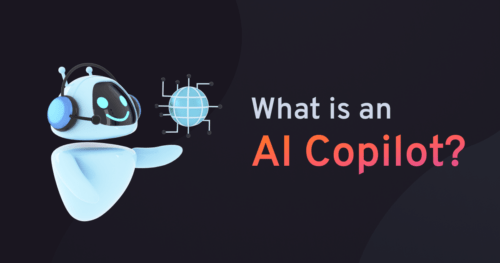What is an AI Copilot?
AI Copilots, also known as Copilot AI, are advanced virtual assistants powered by Artificial Intelligence (AI) to increase productivity and efficiency in any workplace and setting. Using large language models (LLMs) enables natural, human-like conversations by incorporating natural language processing (NLP) to help users with many tasks. AI copilot can assist users without being human, highlighting the evolution from basic chatbots to more advanced AI assistants. The term “copilot” is intentional: like a copilot in an aircraft cockpit, its role is not to take over but to be an intelligent partner to help you navigate complex tasks, manage information, and achieve your goals faster.
While related to basic chatbots and AI assistants, copilots are different because they are deeply integrated into specific workflows and applications. They don’t just answer questions; they participate in the work being done.
AI copilot means different things in different domains and industries. For example, an IT copilot might automate service management by resolving tickets, diagnosing systems, and providing real-time support, while an HR copilot might streamline onboarding, answer policy questions, and help managers track performance.
Here are the key characteristics of an AI Copilot:
- Productivity-Focused: Their main purpose is to help you complete tasks faster and better, whether it’s writing code, drafting an email, analyzing data in a spreadsheet, or managing a project.
- Context-Aware and Integrated: Copilots are built into the software you use every day, like Microsoft 365, Google Workspace, code editors, and enterprise platforms like Salesforce or ServiceNow. They have access to your context – the document you’re writing, the data you’re analyzing – to provide relevant, in-the-moment help.
- Conversational and Intuitive: Using Natural Language Processing (NLP) and Large Language Models (LLMs), you can talk to copilots in plain human language. You can ask them to “summarize this report” or “draft a response to this customer inquiry”.
- Generative Capabilities: Most modern copilots are powered by Generative AI, meaning they can create new content. This includes generating text, code, images, presentation slides, and data summaries from a simple prompt.
How Does AI Copilot Work?
An AI copilot is meticulously designed to boost productivity and smoothen operational processes with a high level of accuracy. They can predict user needs with precision and offer custom solutions. Let’s take a look at the AI Copilot mechanism to see how it works.
AI Copilots work by combining several AI technologies to understand user intent and provide intelligent assistance. Here are the key components:
- Large Language Models (LLMs): At the heart of copilots are large language models, giant neural networks trained on vast amounts of text and data. This training enables them to understand grammar, context, nuance, and complex relationships in information, the foundation for their reasoning and generation capabilities.
- Natural Language Processing (NLP): NLP is the technology that lets the copilot understand and interpret human language. When you type a request or question, NLP breaks it down, figures out what you mean, and translates it into a format the AI can act upon.
- Generative AI: This is the engine that creates new content. After NLP understands the user’s prompt and the LLM does the reasoning, the generative AI component produces the output, whether it’s a paragraph of text, a block of code, a data visualization, or a summary of a meeting.
- Application Integration and Context: A copilot’s real power comes from its integration with specific applications. By accessing data from your documents, emails, calendars, and other enterprise systems, it can provide personalized and contextually relevant suggestions so the output is grounded in your actual work.
Advancements include Domain-specific LLM implementations enhancing security, privacy, and relevance, though typically focused on straightforward tasks.
More complex configurations have multiple LLMs working together to tackle a broader range of challenges by leveraging their combined capabilities and resulting in systems designed for complete organizational support, decision-making, and for large enterprise needs. However, advanced integration requires a substantial investment in infrastructure and careful attention to integration patterns.

AI Copilots Examples and Use Cases
AI Copilots are transformative for enhancing productivity and solving problems. They provide instant guidance for tasks that would otherwise absorb vast amounts of time and resources. These AI copilot use cases include automating instant responses to frequently asked questions like in Bing, assisting account reps in addressing mundane queries in real-time, and even solving complex issues based on historical data. Companies are announcing new features and experiences within AI copilots to enhance productivity.
Spanning retail and e-commerce, insurance, healthcare, telecom & utilities, hospitality & travel, banking & finance, there is virtually no limit to the efficiency and cost savings. AI Copilots are being deployed across a wide range of industries and job functions, transforming how work gets done. Here are some prominent examples and use cases:
- Productivity Suites: Microsoft Copilot is integrated across the Microsoft 365 ecosystem (Word, Excel, PowerPoint, Outlook, Teams). It can draft documents, generate formulas and analyze data in spreadsheets, create presentations from a prompt, summarize meetings, and organize your inbox.
- Software Development: GitHub Copilot is a prime example of a specialized copilot. It acts as an AI pair programmer, suggesting lines of code, autocompleting functions, and even writing entire algorithms based on natural language comments from the developer.
- Business Operations and CRM: Salesforce Einstein Copilot and SAP’s Joule are enterprise-grade copilots tailored for business processes. They can help sales teams by predicting which leads are most likely to convert, suggesting next steps, automating data entry into the CRM, and drafting customer communications.
- Customer Service: In service departments, copilots can summarize long customer support tickets for human agents, suggest relevant answers from the knowledge base, and automate follow-up actions, dramatically improving agent productivity and response times.
- Content Creation and Marketing: Tools like Jasper act as copilots for marketers and writers, helping to generate blog posts, advertising copy, social media updates, and other marketing content in various styles and tones.
- IT and HR Operations: Department-specific copilots can automate internal processes. An IT Copilot can resolve common technical support tickets automatically, while an HR Copilot can answer employee questions about company policies, assist with onboarding, and help managers draft job descriptions.
- Financial Analysis: Copilots for finance can process vast amounts of financial data to identify trends, generate summaries of quarterly reports, and assist analysts in building financial models, speeding up research and analysis.
Enterprise AI Copilots: Enterprise-grade copilots like Agent Copilots are proliferating as major global companies, including Salesforce, Microsoft 365, and ServiceNow, unite their operations across diverse systems and become part of their offerings. These copilots facilitate collaboration, manage and perform tasks, and boost productivity for employees and customers, enhancing morale and satisfaction.
Key Business Benefits of AI Copilots
By embedding into daily workflows, AI Copilots deliver benefits that go beyond task automation. They’re a catalyst for business transformation, driving efficiency, knowledge management, and user empowerment. Here are the benefits:
1. Massive Productivity and Efficiency Gains
This is the most immediate and biggest impact of an AI Copilot. By automating repetitive, time consuming tasks – such as summarizing long documents, drafting routine emails or searching across multiple systems – copilots free up employees to focus on strategic, high value work. They provide real-time assistance and suggestions, reducing the time it takes to find an answer or complete a task from hours to minutes. This increase in individual productivity translates directly to cost savings and operational efficiency across the whole business.
2. Better Information and Decision Making
One of the biggest challenges in any business is finding accurate, relevant, and up to date information. An Enterprise AI Copilot solves this by connecting to your internal knowledge repositories and trusted third party sources. It delivers context aware answers based on your company’s specific data, so the information provided is not just generic but precise and reliable. This means employees can make better, faster, and more informed decisions with confidence.
3. Better Employee and Customer Experience
AI Copilots change how people interact with technology and each other. They provide seamless omnichannel support so users can get help on their preferred platform, whether that’s Microsoft Teams, Slack, a web portal, or a mobile app. With built-in multilingual capabilities, they break down language barriers for global teams and customers. And by being an “agent assist”, they help users learn new skills and master existing ones, leading to higher job satisfaction, reduced frustration, and a more empowered workforce.
4. More Creativity and Continuous Improvement
Copilots are a tool for augmenting human creativity. They can help teams brainstorm ideas, overcome writer’s block, and enrich their work with generated images or polished presentations. Beyond that initial creative boost, these AI systems are designed for continuous learning. As they’re exposed to new data and interactions within your business, they adapt and refine their understanding, becoming more attuned to your business needs, industry jargon, and unique challenges over time.

Ethics, Governance, and Reliability of AI Copilots
The scope of AI ethics spans immediate concerns such as bias, data privacy, and transparency in AI systems. Those deploying AI should be accountable for their actions. To mitigate and prevent risks, governments and AI industry leaders are rolling out AI governance policies and responsible AI initiatives.
Guiding principles include justice, fairness, reliability, privacy and security, inclusivity, transparency, and accountability, all of which should govern AI development and use. The AI TRiSM framework is a standard to help with these obstacles
AI has brought ethics to the foreground, along with security and privacy. Phenomena like deepfakes and misinformation can be perpetuated by AI-generated texts or media and threaten objectivity, with the risk of polarizing societies. If training data harbors biases, outputs may reinforce stereotypes, leading to skewed and unfair results.
Dealing with bias is an ethical consideration with traditional machine learning systems and a clearly defined data set. When scaling large foundational models like those used for code, text, or image generation, you need policies or controls in place to detect biased outputs and deal with them consistently with company policy and relevant legal requirements.
Inclusiveness: AI systems should empower and engage people. This principle seeks to include all human races’ experiences. Where possible, speech-to-text, text-to-speech, and visual recognition should be used to empower those with hearing, visual, and other challenges.
Reliability and Safety: For AI systems to be trusted, they must be reliable and secure. Rigorous testing and validation must be deployed, and a robust monitoring and model tracking process needs to reactively and proactively measure performance and retrain as necessary.
When it comes to cybersecurity, companies need to prepare for the potential of malicious actors using AI systems for cyber and fraud attacks. Companies should confer with their cyber-insurance provider to verify that their existing policy covers AI-related breaches.
Other Challenges with Leveraging AI Copilots
While AI Copilots have many benefits, there are also some challenges to consider. You must view AI Copilots as tools to augment human capability – not replace them. To get the most out of them, organisations need to invest in ongoing training and upskilling so employees can work with AI.
Businesses also need to align internal processes with AI capability by integrating AI Copilots into existing workflows and making human-AI interaction seamless. And there’s the risk of AI mistakes due to AI hallucinations, where the copilot generates incorrect or misleading responses. If left unchecked, these can lead to misunderstandings or bad decisions.
By addressing these challenges proactively, you can unlock the real power of AI Copilots to drive efficiency, innovation, and growth.
Future Trends and Directions for AI Copilots
It’s a sure thing that AI Copilot will keep getting more features and capabilities. “People will feel more digitally understood than ever,” says Accenture. We used to have to enter data into a screen and then click to get to another area. Now we can use natural language processing and understanding to simply ask or request, and the copilot will get the info for us.
With agentic AI, these copilots can proactively help us by anticipating our needs and delivering personalized insights to make us more efficient. Microsoft’s customers are loving Copilot. 70% of early users feel more productive, and 68% say it’s improved the quality of their work.
No surprise, over 60% of Fortune 500 companies are using Copilot, and 77% of employees don’t want to go back to work without it, according to Jared Spataro, CVP Modern Work and Business Applications, who shared this at the 2023 Microsoft Ignite event.
And to top it all off, 85% of users felt they got to a first draft faster, 71% felt rescued from tedious tasks, 64% felt relieved from email.
Though these statistics speak for themselves, it’s vital to understand the capabilities of the particular AI Copilot you are considering vis a vis your company’s unique needs. Copilots will quickly become integral to your organization, a close ally that reaches across your systems to increase productivity, improve performance, and drive ROI with AI. So, choose the right platform that best aligns with your industry, domain, and technology environment in order to optimize its value.

Evaluating Key Considerations to Choose AI Copilots
When choosing an AI Copilot (Copilot AI), it’s smart to work on galvanizing excitement and educating users. Focus on the features and capabilities that an AI Copilot brings in terms of productivity, performance, and user satisfaction. The following considerations help you realize optimal results.
Data security and compliance: Evaluate your choice of AI Copilot in terms of solid security, regulatory compliance, and confidentiality/privacy across personal, group, and users.
Enterprise fit and context: Ensure that the AI Copilot you consider comprehends your context and can leverage your business-specific data accurately and securely.
Integration and Scalability: Be sure that your AI Copilot is robust enough to scale as you grow and that it is capable of integrating smoothly with your enterprise-wide applications.
Engage people during implementation and address issues promptly to maintain the process a positive one. Finally, work on your roadmap to stay in control of business impact when you adopt AI Copilots. The journey is exciting, unique, and historical, and you are all an integral part of it.
Getting Started with AI Copilot
Before delving into the innovative world of Generative AI with our AI Copilot solutions, it is crucial for enterprises to precisely define their application focus, be it enhancing employee experiences, elevating customer interactions, optimizing operational efficiencies, or refining voice experiences.
Identifying the specific domain of application will ensure that the AI Copilot is tailored to meet and exceed the unique requirements of your organization, thereby maximizing productivity and fostering exceptional experiences across all fronts.
AI Copilot for Employee Experience (EX): AI Service Desk as an AI-enhanced employee experience platform Drives productivity and operational efficiency with enterprise LLM and Generative AI. Human-like conversations and self-service resolve complex tasks while preemptively fixing technical issues.
AI Copilot for Customer Experience (CX): AI Customer Service propels retention rates, reduces wait times, boosts customer loyalty, and grows revenue. Automate requests and issue resolution conversationally while dramatically improving agent productivity.
AI Copilot for Ops Experience (OX): An AIOps platform can detect and resolve major incidents and performance issues proactively, for timely notifications on the health status of infrastructure and apps. Predict outage effects and more in accurate natural language.
AI Copilot for Voice Experience (VX): AI Voice Bot can Streamline customer support with voice experience to solve concerns on first contact. Tailor responds to your needs and even automates complex requests with AI Workflow Automation.
Learn more on how Aisera’s Enterprise AI Copilot can accelerate efficiency and deliver exceptional employee and customer experiences. Book a custom AI demo today!

